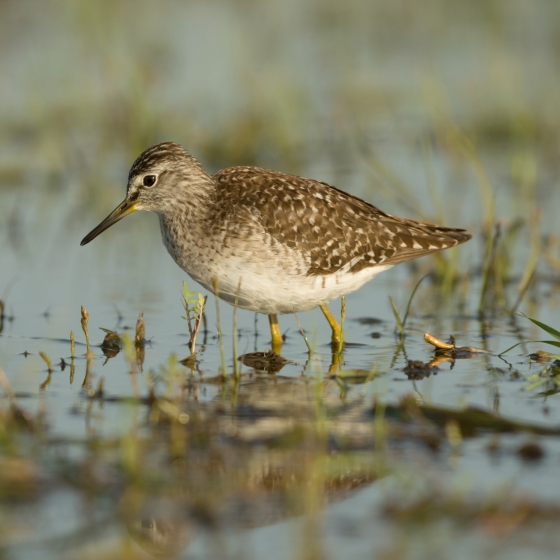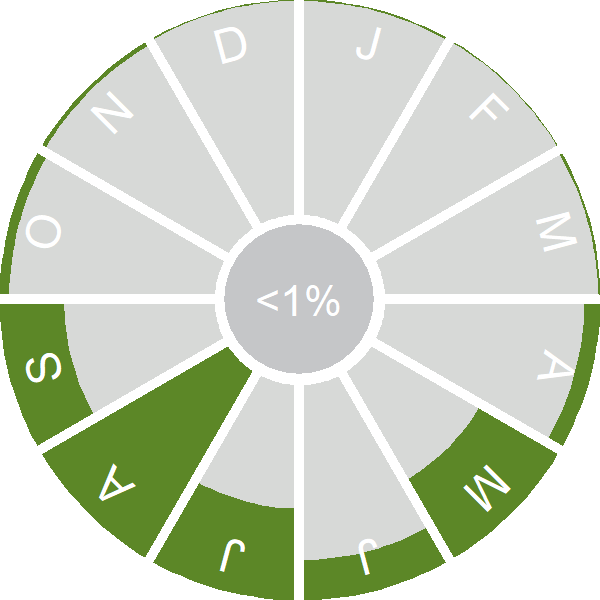Wood Sandpiper

Introduction
Wood Sandpiper is a smart wader with elegant proportions. A strong eye stripe and speckled plumage combine to make this a very attractive bird.
Although Britain hosts a small breeding population, confined to the boggy habitats of the very north of Scotland, most birdwatchers are likely to encounter Wood Sandpiper as a passage migrant, mainly in spring.
Migrating Wood Sandpipers break their journey to refuel, preferring small shallow wetlands with plenty of emergent vegetation. Individuals using such sites can be surprisingly difficult to see as they forage amongst the tall plants. In flight, Wood Sandpipers show off dark upperparts and a square white-rump, and they often call with a quickly repeated reedy whistle as they fly away.

Key Stats
Identification
ID Videos
This section features BTO training videos headlining this species, or featuring it as a potential confusion species.
Wood and Green Sandpipers
Songs and Calls
Song:
Call:
Status and Trends
Conservation Status
Population Change
The small population of Wood Sandpiper breeding in Scotland has increased strongly since the 1960s (Chisholm 2007), and particularly over the last 25 years, to a five-year mean of 36 breeding pairs over the period 2015–2019 (Eaton et al. 2021). The European population is believed to be stable and has maintained it's range in recent decades (Keller et al. 2020).
Distribution
Wood Sandpipers are very rare breeding waders of boggy habitats in Scotland. Owing to the sensitivity of some of its breeding haunts, breeding distribution is shown here at 50-km resolution. Most breed in Sutherland and Caithness, but also in Inverness-shire, Wester Ross and the Outer Hebrides.
Occupied 10-km squares in UK
2007/08–10/11
or view it on Bird Atlas Mapstore.
2008–11
or view it on Bird Atlas Mapstore.
European Distribution Map
Distribution Change
Range size and population size have both increased slightly since the early 1990s.
Change in occupied 10-km squares in the UK
from 1981–84 to 2007–11
or view it on Bird Atlas Mapstore.
from 1968–72 to 2008–11
or view it on Bird Atlas Mapstore.
Seasonality
Wood Sandpiper is a summer visitor and passage migrant in spring and autumn.
Weekly pattern of occurrence
The graph shows when the species is present in the UK, with taller bars indicating a higher likelihood of encountering the species in appropriate regions and habitats.

Movement
Britain & Ireland movement
Foreign locations of birds ringed or recovered in Britain & Ireland
Dots show the foreign destinations of birds ringed in Britain & Ireland, and the origins of birds ringed overseas that were subsequently recaptured, resighted or found dead in Britain & Ireland. Dot colours indicate the time of year that the species was present at the location.
- Winter (Nov-Feb)
- Spring (Mar-Apr)
- Summer (May-Jul)
- Autumn (Aug-Oct)

European movements
EuroBirdPortal uses birdwatcher's records, such as those logged in BirdTrack to map the flows of birds as they arrive and depart Europe. See maps for this species here.
The Eurasian-African Migration Atlas shows movements of individual birds ringed or recovered in Europe. See maps for this species here.
Biology
Productivity and Nesting
Nesting timing
Egg measurements
Clutch Size
Survival and Longevity
Survival is shown as the proportion of birds surviving from one year to the next and is derived from bird ringing data. It can also be used to estimate how long birds typically live.
View number ringed each year in the Online Ringing Report.
Lifespan
Survival of adults
Biometrics
Wing length and body weights are from live birds (source).
Ring Size
Classification, names and codes
Classification and Codes
- Order: Charadriiformes
- Family: Scolopacidae
- Scientific name: Tringa glareola
- Authority: Linnaeus, 1758
- BTO 2-letter code: OD
- BTO 5-letter code: WOOSA
- Euring code number: 5540
Alternate species names
- Catalan: valona
- Czech: vodouš bahenní
- Danish: Tinksmed
- Dutch: Bosruiter
- Estonian: mudatilder
- Finnish: liro
- French: Chevalier sylvain
- Gaelic: Luatharan-coille
- German: Bruchwasserläufer
- Hungarian: réti cankó
- Icelandic: Flóastelkur
- Irish: Gobadán Coille
- Italian: Piro piro boschereccio
- Latvian: purva tilbite
- Lithuanian: miškinis tikutis
- Norwegian: Grønnstilk
- Polish: leczak
- Portuguese: maçarico-de-dorso-malhado
- Slovak: kalužiak mociarny
- Slovenian: mocvirski martinec
- Spanish: Andarríos bastardo
- Swedish: grönbena
- Welsh: Pibydd Graean
Research
Causes of Change and Solutions
Causes of change
It is not clear why the number of breeding Wood Sandpipers has increased. It has been suggested that the increases in some years could be due to increased numbers of migrants, some of which remain to breed (Chisholm 2007), but this is speculative.
More Evidence
More evidence from Conservation Evidence.com
Partners
Citing BirdFacts
If you wish to cite particular content in this page (e.g. a specific value) it is best to use the original sources as linked in the page. For a more general citation of the whole page please use: BTO (20XX) BirdFacts Species: profiles of birds occurring in the United Kingdom. BTO, Thetford (www.bto.org/birdfacts, accessed on xx/xx/xxxx).

